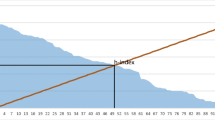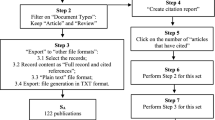Abstract—
In the article, the issues of normalization of scientometric indicators of the publication level were studied. An integrated approach to the evaluation of research results was formalized. The similarities and differences between professional and scientific communities were considered. The concept of a professional scientific community was introduced. Local and network subtypes of scientific communities were identified. A method has been developed for obtaining the values of scientometric indicators normalized by both local and network scientific communities, the distinguishing feature of which is the use of linguistic variables and production rules of fuzzy logic. The testing of the proposed methodology was carried out based on the example of a scientometric database.



Similar content being viewed by others
REFERENCES
Dutta, B., The journey from librametry to altmetry: A look into the past, Mezhdunar. Forum Inf., 2015. vol. 40, no. 2, pp. 3–12.
Zinov'eva, I.V., Inozemtseva, S.N., Kosarenkova, M.I., Markusova, V.A., Mindeli, L.E., Solomentseva, O.A., and Solopova, M.A., Nauka, tekhnologii i innovatsii Rossii: Krat. stat. sb. (Science, Technology, and Innovation of Russia: Small Statistical Book), Mindeli, L.E., Ed., Moscow: Inst. Probl. Razvit. Nauki Ross. Akad. Nauk, 2017.
Varganova, T.N., Zinov’eva, I.V., Inozemtseva, S.N., Markusova, V.A., Solomentseva, O.A., Solopova, M.A., and Kosarenkova, M.I., Nauchnyi potentsial Rossii za 2006–2014 gody: Analit.-stat. sb. (The Scientific Potential of Russia for 2006–2014: Analytical-Statistical Book), Mindeli, L.E., Ed., Moscow: Inst. Probl. Razvit. Nauki Ross. Akad. Nauk, 2017.
Gorodnikova, N.V., Gokhberg, L.M., Ditkovskii, K.A., Kotsemir, M.N., Kuznetsova, I.A., Lukinova, E.I., Martynova, S.V., Ratai, T.V., Rosovetskaya, L.A., Sagieva, G.S., Strel’tsova, E.A., Suslov, A.B., Tarasenko, I.I., Fridlyanova, S.Yu., and Fursov, K.S., Indikatory nauki: 2018: Stat. sb. (Indicators of Science: 2018: Statistical Book), Gokhberg, L.M., Kuz’minov, Ya.I., Laikam, K.E., and Matveev, S.Yu., Eds., Moscow: Nauchno-Issled. Univ. Vyssh. Shk. Ekon., 2018.
Science & Engineering Indicators 2018. National Science Board. https://nsf.gov/statistics/2018/nsb20181/ assets/nsb20181.pdf.
Bornmann, L. and Marx, W., Critical rationalism and the search for standard (field-normalized) indicators in bibliometrics, J. Inf., 2018, vol. 12, no. 3, pp. 598–604.
Mart’yanova, N.A., Construction of professional associations: From professional groups to expert communities, Izv. Ross. Gos. Pedagog. Univ. im. A. I. Gertsena, 2013, no. 162, pp. 136–140.
Maslova, Yu.V., Social professional communities: Typology, structure, and purpose (on the example of the library community), Materialy elektronnoi Vserossiiskoi nauchnoi konferentsii “Professional’noe bibliotechnoe soobshchestvo XXI veka: professionalizm, grazhdanstvennost', tolerantnost'" (Proceedings of the Electronic Library Conference Professional Library Community of the 21st Century: Professionalism, Citizenship, and Tolerance), Kalegin, O.A. and Kormishin, G.M., Eds., Kazan: Kul’tura, 2011, pp. 74–85.
Loiko, V.I., Loiko, V.I., Romanov, D.A., Kushnir, N.V., and Kushnir, A.V., Qualimetric assessment of integration of scientific staff into the scientific community based on citation analysis, Politemat. Setevoi Elektron. Nauchn. Zh. Kuban. Gos. Agrarn. Univ., 2016, no. 118, pp. 1168–1186.
Titov, V.N., Institutional and ideological aspects of the functioning of science, Sotsiol. Issled., 1999, no. 8, pp. 62–70.
Feigel'man, M.V. and Tsirlina, G.A., Bibliometric passion as a result of the lack of scientific expertise, Upr. Bol’shimi Sist.: Sb. Tr., 2013, no. 44, pp. 332–345.
Garcia, N.R., Salinas, D.T., Zahedi, Z., and Costas, R., New data, new possibilities: Exploring the insides of Altmetric.com, Prof. Inf., 2014, vol. 23, no. 4, pp. 359–366.
Yurevich, M.A. and Tsapenko, I.P., Prospects for the use of altmetrics in the social sciences and humanities, Inf. O-vo., 2015, no. 4, pp. 9–16.
Gureev, V.N. and Mazov, N.A., The place of altmetrics in quantitative methods for assessing scientific activity, Inf. Innovatsii, 2018, no. 1, pp. 18–21.
Ramos-Vielba, I., D’Este, P., Woolley, R., and Amara, N., Introduction to a special section: Balancing scientific and societal impact—a challenging agenda for academic research, Sci. Publ. Policy, 2018, vol. 45, no. 6, pp. 749–751.
Vlasov, V.V., The value of scientific publications in specialized journals, Profil. Med., 2010, vol. 13, no. 4, pp. 44–47.
How is the Altmetric Attention Score calculated. https:// help.altmetric.com/support/solutions/articles/6000060969-how-is-the-altmetric-score-calculated-.
Galyavieva, M.S., Altmetrics and libraries: Trends, opportunities, and problems, Vestn. Kazan. Gos. Univ. Kul’t. Iskusstv, 2013, nos. 4-1, pp. 27–32.
Schreiber, M., Malesios, C.C., and Psarakis, S., Exploratory factor analysis for the Hirsch index, 17 h-type variants, and some traditional bibliometric indicators, J. Inf., 2012, vol. 6, no. 3, pp. 347–358.
Waldrop, M.M., Science 2.0: Great new tool, or great risk?, Sci. Am., 2008, vol. 298, no. 5, pp. 69–73.
Efimova, G.Z., Analysis of the effectiveness of scientometric indicators in the evaluation of scientific activity, Vestn. Tyumen. Gos. Univ., Sots.-Ekon. Pravovye Issled., 2012, no. 8, pp. 101–108.
Batygin, G.S. and Gradosel’skaya, G.V., Network communications in the professional community of sociologists: Methodology for content-analytical research of biographies, Sotsiol. Zh., 2001, no. 1, pp. 88–109.
Hood, W. and Wilson, C., The literature of bibliometrics, scientometrics, and informetrics, Scientometrics, 2001, vol. 52, no. 2, pp. 291–314.
Medynskaya, M.K., Theory of fuzzy sets. The concept of a fuzzy set, Mezhdunarodnaya konferentsiya po myagkim vychisleniyam i izmereniyam (International Conference on Soft Computing and Measurement), 2015, vol. 1, pp. 46–48.
Rotshtein, A.P. and Shtovba, S.D., The influence of defuzzification methods on the tuning speed of a fuzzy model, Kibern. Sist. Anal., 2002, no. 5, pp. 169–176.
Funding
This work was carried out as part of a study on the topic 0003-2019-0001 of the state task of the VINITI RAS.
Author information
Authors and Affiliations
Corresponding author
Ethics declarations
The authors declare that they have no conflict of interest.
Additional information
Translated by S. Avodkova
About this article
Cite this article
Kalachikhin, P.A. Comparison of Research Results by Scientific Communities. Autom. Doc. Math. Linguist. 53, 179–188 (2019). https://doi.org/10.3103/S0005105519040071
Received:
Published:
Issue Date:
DOI: https://doi.org/10.3103/S0005105519040071




